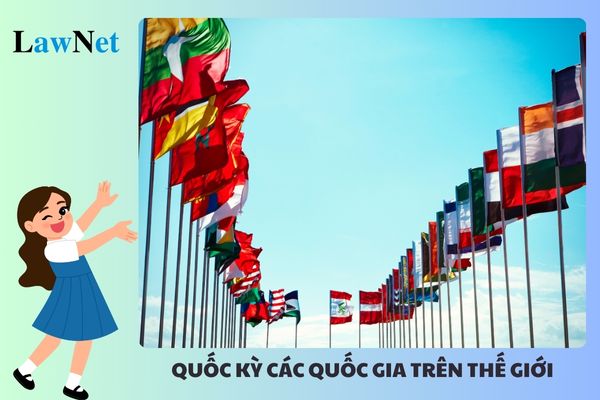What are national flags of all countries in the world? When do students in Vietnam learn the latitudes and longitudes on the world map?
What are national flags of all countries in the world?
As of now, there are a total of 204 countries in the world, divided into 5 different groups:
Group 1: 193 countries recognized and are members of the United Nations.
Group 2: 02 countries, Palestine and Vatican, are in the process of being observed by the United Nations. (Recognized in 2015)
Group 3: 02 territories widely recognized by multiple countries, Kosovo (member 111/193) and Taiwan (member 19/193).
Group 4: Several countries recognized by international entities but not independent in governance such as Western Sahara.
Group 5: 06 countries and territories that have declared independence but are not internationally recognized, including Abkhazia, Northern Cyprus, Nagorno-Karabakh, Transnistria, and Somaliland.
The national flags of all the countries in the world are shown below:

Note: The content concerning the national flags of all countries worldwide is for reference only!

What are national flags of all countries in the world? When do students in Vietnam learn the latitudes and longitudes on the world map? (Image from Internet)
When do students in Vietnam learn the latitudes and longitudes on the world map?
In the History and Geography Curriculum issued together with Circular 32/2018/TT-BGDDT, the requirements for contents of Map - A tool showing the Earth's surface included in the grade 6 curriculum are as follows:
- Identifying on the map and the Globe: the prime meridian, the equator, the hemispheres; recording the geographical coordinates of a location on the map.
- Recognizing some longitude and latitude grids on the world map.
- Knowing how to read map symbols and explanations for administrative maps and topographical maps.
- Determining direction on the map and calculating the actual distance between two locations on the map by its scale.
- Reading maps, identifying the locations of geographic objects on maps.
- Finding routes on maps.
- Drawing mental maps showing familiar geographic objects to the student.
Thus, grade 6 students need to recognize some longitude and latitude grids on the world map.
What are guidelines on demonstrating the levels of response to requirements in the History and Geography curriculum for lower secondary school level in Vietnam?
Based on the General Education Program for History and Geography issued together with Circular 32/2018/TT-BGDDT, during the teaching process, especially when posing discussion questions, designing assessment tasks, teachers can use the verbs listed in the table or substitute them with equivalent verbs suited to the pedagogical situation and specific tasks assigned to students as follows:
| Level | Description Verbs |
| Know | - Name (types of minerals); state (some Northern feudal policies; the results of the religious reform); define (a concept, term); list (events, entities, individuals); recount/repeat; provide evidence; give examples,... - Identify (Earth's position in the Solar System; one/more geographical objects on the map, simplified map); correctly place (an object on the map, diagram); fill in (blanks, appropriate keywords); connect (missing lines on diagrams); match pairs (words with logical relationships),... - Search for information (articles, images using search tools, keywords); find (objects, routes on maps),... |
| Understand | - Describe (the internal structure of the Earth; the distribution of geographical objects); state/describe (the distribution characteristics of main industrial centers; major events); read maps, describe (nature along a cross-section on maps; geographical objects encountered on a tourist route); draw simple charts (without data manipulation); create (historical progress charts, major episode charts); describe (material and spiritual life); use simplified maps (introduce the journey of some geographical discoveries); present (important societal changes),... - Analyze the impact, mutual relationships, and causal relationships (between natural geographical components/processes; socio-economic processes; nature's impact on social production; human impact on nature); analyze the success or failure reasons (of a historical event, movement); describe (the relationship between urban areas and ancient civilizations),... - Differentiate (terrain types; natural exploitation methods); compare (climatic features of two locations; population distribution in two regions); rank (population density in provinces, cities; industrial production value of provinces/cities); assess; group/classify objects (based on some criteria and indicators; for instance, classify provinces with high socio-economic development difficulties, justify the selection); evaluate (the significance and impact of an event),... |
| Apply | - Determine (direction in the field, local time); explore (through documentation and visits) a specific issue, historical and geographical topic; relate (local reality); pose questions (about an issue); discover,... - Propose (preventive measures against natural disasters, respond to climate change in a specific region); apply (learned knowledge) to specific cases, specific contexts; suggest (solutions); make (recommendations). - Construct/draw (memory maps to summarize lesson content, appropriate charts); diagrammatize (a phenomenon, process, causal relationship); build a dossier (on an issue); read Atlases (extract information from different map pages) to describe (a specific issue on the development and distribution of an economic sector, natural and socio-economic characteristics of a territory); write a short report (based on collected and analyzed, aggregated information from different sources); give a presentation about an issue using PowerPoint (as the result of individual or group work); debate (an issue); plan (a one-day study tour under the teacher's guidance); design (a poster on environmental protection),... |

